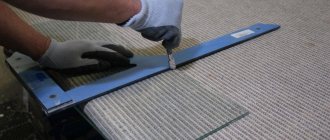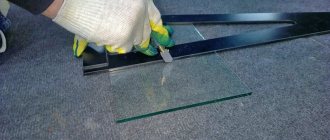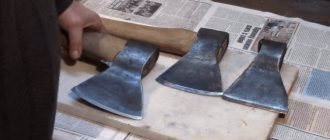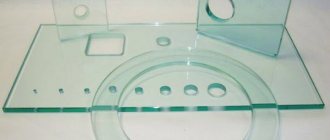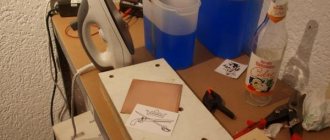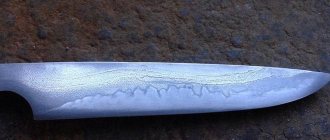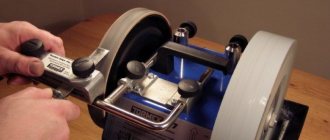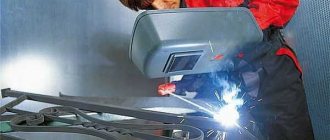Sooner or later, a household may need to replace glass on its own.
But working with such fragile material is very dangerous. Therefore, in order to avoid injuries and unnecessary consumption of material, you should know the basic rules for working with this material and the selected tool. Cutting ordinary glass is very simple and will not cause any difficulties for a person. You can cut such glass with a special glass cutter or even ordinary scissors.
If you have no idea how to properly handle this tool, you can watch numerous videos on this topic on our website. They will help you cut out the desired shape and provide the necessary information on working with a rather complex and fragile material like glass.
Types of glass and features of work
Cutting ordinary glass does not pose any difficulties. Not only glass cutters, but also ordinary tailor’s scissors do an excellent job with this task. But what should those who have set themselves the task of obtaining a glass product with a more complex configuration do? To do this, it is worth familiarizing yourself with the properties of some glasses.
- Tempered glass products . In fact, it is impossible to cut tempered glass at home - it loses its properties. If you want to purchase an item with elements of this material, it is worth considering cutting it in the early stages. In addition, work with it must be carried out by professionals, since the hardening process of the resulting product can only be carried out under certain conditions.
- Fluted glass . This patterned glass is especially popular in glazing doors or creating decorative interior elements. Unlike tempered glass, you can cut such glass yourself. Working with it is not much different from working with ordinary glass, the only difference is that the cut is made from the smooth side. A roller glass cutter is best suited for this.
- Acrylic or organic glass is a transparent plastic created on the basis of synthetic resins. No special tools are required to cut it. At home, a metal saw, cutter and other tools used for edge processing do an excellent job of this task. In addition, a regular stationery knife can handle glass whose thickness does not exceed 2 mm.
In any case, it is worth remembering that working with any glass must be accompanied by compliance with certain precautions. The presence of thick gloves and safety glasses are the main conditions for ensuring your own safety. It will not be superfluous to take care of the arrangement of the workplace. Since working with glass involves the presence of fragments, cover the work surface with any material that you won’t mind getting rid of. Feeling safe will allow you to achieve the best results.
Frame installation technology
Before starting installation, it is necessary to prepare a place for attaching the cut workpiece. Its working surfaces must be completely cleaned of old nails, paper clips, and putty. It is important to ensure a uniform plane of glass contact to all edges without distortions.
Any unevenness found is leveled and filled with putty. It is not difficult to buy or make it yourself.
Types of putties
Putty with chalk
Compound:
- drying oil - 220 g;
- ground chalk - 810 g.
Putty with chalk and white
Compound:
- drying oil - 180 g;
- ground chalk - 600 g;
- dry whitewash - 200 g.
Cooking technology:
- chalk is poured in a slide;
- a notch is made on top;
- pour drying oil and/or white into it;
- mix the ingredients until it forms a dough.
How to fix glass
At home, two installation methods are used:
- on putty;
- glazing bead
It is convenient to hammer in the nails for fastening the glazing bead not with a hammer, but with the side surface of a chisel. The blows are applied by making an oblique cut while sliding along the glass.
Before cutting glass
The main knowledge of a glazier is knowing how to cut glass correctly, so that the required size and shape is obtained, as well as so that the edges are smooth and without chips.
Previously, both glass and the tools for processing it were expensive and only craftsmen with good skills were engaged in cutting glass, but in our time the situation has changed significantly. Nowadays, anyone can work with glass.
Tool
To work with glass, you need a very good tool.
That’s why, before you buy glass and work with it, you need to start shopping with the tool.
But you shouldn’t buy the first tool you come across, because it may be of poor quality and will not be able to cut the glass as needed.
It is very important to determine what tool you need, because there are several types of glass cutters:
- Roller;
- Diamond;
- Oily;
Roller
The roller glass cutter for cutting glass has a built-in special roller, which is made of a very durable tungsten-cobalt alloy. The usual roller diameter is 6.6 mm, this roller diameter allows cutting glass up to 4 mm thick.
Diamond
The diamond glass cutter is equipped with a correspondingly small diamond, this diamond cuts glass. The hardness of diamond is well known and therefore it has long been used for cutting glass.
Nowadays, as before, a diamond glass cutter is considered the best tool for cutting glass.
Oily
Not long ago, an oil glass cutter was added to the list of glass cutters.
This is essentially an improved roller tool that has a reservoir built into the handle to supply lubricant to the roller. This lubricant binds particles that were formed when cutting glass while ensuring smooth movement. This glass cutter can cut glass up to 20 mm.
Workplace
Glass does not withstand local lateral loads well. The pressure from the glass cutter is what causes them. Therefore, a home craftsman should work with glass only on a prepared, clean and level surface.
A coating made from a solid sheet of fiberboard and similar materials is well suited. It is perfectly acceptable to cover a regular table with a blanket and cut on it.
A little theory
Glass production is based on melting and subsequent cooling of minerals of various compositions. After completion of the technological processes, a transparent, relatively durable structure is created. It normally withstands mechanical loads uniformly applied to the entire plane, but does not withstand local impacts well.
Conventional cutting relies on scratching with the hard, sharp edges of a glass cutter roller. They reduce the strength of the surface and at the same time form microcracks, which, under the influence of operational loads, for example, gusts of wind, snow pressure, lead to destruction during operation.
During casting at the factory, a high-quality glass edge is created without any defects that reduce the mechanical characteristics of the sheet. Let's consider how it is formed with a conventional construction glass cutter or its industrial automatic analogue.
How to cut glass
A sheet of glass is not as easy to cut as it seems at first. To make a glass cut, preparation is necessary.
Preparation
- Absolutely new glass will only need to be thoroughly cleaned of dust and wiped dry with newspaper; fabric is not suitable for such work.
- If you have to cut old glass, you should first degrease it, after which the glass is washed well with water and detergents.
- After all the above manipulations, the glass will need to be dried in a closed and clean room.
Cut glass
Preparatory work also includes cutting glass and preparing containers for waste collection. There should be two containers, that is, for collecting small waste and for collecting larger ones, which may be useful for something in the future.
When cutting glass, it is best to start with simple window glass and then move on to more complex options.
How to properly scratch
When cutting a groove, loads are created that work to shear the surface layer.
They cause deformations that form microscopic surface, lateral and deep cracks.
The correct cut is ensured only by those microcracks that are directed into the depth of the material - the middle ones. All others are not needed. They must be avoided.
The cutting quality is affected by:
- cutter sharpening angle;
- roller diameter;
- pressure on glass;
- position of the cutting organ.
Glass cutting technique
- First you need to prepare a table or other surface for cutting glass. The surface is covered with four or five layers of newspaper; this procedure is necessary to protect the table from glass chips. This will also distribute the pressure of the glass onto the table surface, preventing the glass from cracking.
- The glass sheet is placed on the table, and it is necessary to retreat five or seven centimeters from the edge of the tabletop. In order to fix the body and at the same time move the body freely above the cut site, it is best to place your feet shoulder-width apart. This body position allows you to achieve good results.
- When cutting glass, it is best to hold the blade with your free hand to avoid vibration. But keep in mind that glass is a fragile material and with more pressure it can crack.
- Use a glass cutter to draw a line from one edge to the other. In this case, the glass cutter wheel must be guided clearly along the marked line and the glass cutter must also be at a right angle.
When using a diamond glass cutter , you need to hold it at the very bottom of the handle and smoothly draw a line along the ruler, almost without pressing on the glass.
When cutting glass with a roller glass cutter, slight pressure is required and when the glass cutter moves, a whitish stripe appears on the glass surface, deeper than when using a diamond tool.
How does the roller sharpening angle affect the cut?
As an example, let’s look at the designs of three cutters designed to work on industrial glass cutters of automatic robots.
The direction of the forces pushing the surface layer apart when creating a scratch is always perpendicular to the pressing plane. A sharper roller deflects the acting force more widely from the normal to the surface, creating a smaller area of stress penetration.
To cut thick glass, use a tool with a wider sharpening angle, and for thin materials, use sharp ones.
On factory models of glass cutters, the sharpening angle is already created to work with standard glass used for domestic purposes.
How does the roller diameter affect the cut?
Smaller dimensions allow better scratching of the outer surface of the workpiece. However, the designs of the glass cutter have already been adjusted at the factory to optimal performance, and the home craftsman will not be able to change anything here.
The tool is purchased ready-made with standard roller diameters. As they lose their sharpness, which rarely occurs in everyday life, the dull part is simply replaced with a backup one.
How does pressure on the roller affect the cut?
The depth of penetration of a scratch into the glass depends on the applied cutting force. When choosing a sharper cutter for thin material, you should take into account that it is dangerous to create a high load with it, because you can simply crush the material.
To make it easier to cut the workpiece when performing such work, always ensure that the glass is clean and treat its surface with special liquids that:
- lubricate the roller;
- provide a hydraulic cushion;
- reduce the effect of the Rebinder effect, reducing the strength of the outer surface;
- wedge the material.
At home, you can easily get by with kerosene for these purposes. It is convenient to apply it manually with a piece of rag or use a specially designed glass cutter.
How does the roller position affect the cut?
The picture with the sharpening angles of the cutter makes it clear that the roller must be guided strictly perpendicular to the glass surface.
Its deviation from the normal will lead to lateral displacement of the median crack and incorrect chipping.
About the number of cuts
There is a misconception among beginners that one scratch is not enough and that several repetitions must be done. They say they will deepen the crack. So such masters use a glass cutter several times in the same place.
This is a gross mistake: with each movement, repeated deformations of the material and additional cracks are created in all directions. They reduce the overall strength of the workpiece and can lead to improper fracture during bending.
Possible mistakes
When there is a river of glass, there are two mistakes:
- The pressure with a glass cutter can be too strong;
- The glass cutter is carried out several times in the same place.
What tools to use?
Many of us are accustomed to thinking that glass can only be cut correctly and efficiently with a glass cutter. But what to do if you need to cut a piece of glass urgently, but you don’t have this tool at hand? There is another unusual, but no less effective method that helped our great-grandfathers get out of this situation. Such a tool is ordinary scissors, available to any owner. Let's look at each method in detail.
Option 1: glass cutter
The technology for cutting glass with a glass cutter is quite simple. To do this, you must comply with certain conditions and choose the right glass cutter. Today, the choice of this tool is quite wide, which allows you to turn work into pleasure.
- Diamond glass cutter, time-tested and remains a leader in its field to this day. Glass cutters with a beveled cutting edge are suitable for home use. This tool is designed to cut glass up to ten kilometers and is suitable for any thickness of the material used. From time to time, such a glass cutter needs to be sharpened on a special whetstone.
- Roller. As the name suggests, the cutting part of such a glass cutter is made in the form of a roller made of a durable cobalt-tungsten alloy. The number of rollers can be from one to six.
- Oil. This tool works on the principle of a roller glass cutter, with the difference that a reservoir with oil is built into its handle, which is automatically supplied to the roller. Suitable for cutting thick glass.
To learn how to choose a good glass cutter, watch the video:
So, having dealt with the glass cutter, place the glass on a flat surface. Mark the glass and get to work. To make the task easier, you can use a ruler. It is worth considering the point that the line must be drawn the first time, otherwise a repeated attempt will lead to cracking of the surface. When cutting glass with a glass cutter, you need to apply equal force along the entire length of the line.
Option 2: ordinary scissors
Cutting glass with scissors like paper is not a fairy tale, but a completely everyday reality. For this purpose, you will need the scissors themselves (sewing scissors are best for this) and a tank of water (preferably hot). It is necessary to apply markings on the glass in advance, and then elementary physics comes into play: scissors create a microcrack, and the capillary effect completes the process. Of course, the result obtained will differ from that achieved with a glass cutter, but if necessary, this method can help out significantly.
How to cut glass at home without a glass cutter
Twine, gasoline and lighter
The method described below will tell you how to cut glass evenly if you don’t have a glass cutter at hand. Everyone knows that the material is afraid of sudden temperature changes. This property can be used to cut it. For work you will need: twine with a maximum thickness of 2 mm (cotton only), lighter, gasoline (kerosene).
The glass sheet is placed on the table and a line along which it needs to be cut is marked with a marker. Measure and cut the twine so that it covers the entire length of the cut. After that, it is poured with gasoline and applied to the line on the glass. The twine must be set on fire so that it lights up along its entire length. When the thread goes out, water it with cold water. As a result, the glass will crack at the location of the temperature difference. If the crack does not extend across the entire sheet, then you need to repeat the procedure and lightly tap along the cut line.
Soldering iron
A straight cut is not always needed, and in this situation a file and soldering iron will help out. If you don’t have a soldering iron, a wood burning device will do.
The process is long but creative. First, mark the glass and use a marker to draw a cutting line on it. Then, at the edge, at the beginning of the mark, using a file, make a groove, which will serve as a guide. Having retreated a couple of millimeters along the line, use a soldering iron to heat the glass until a crack appears from the groove to the heating point. Then they retreat another couple of millimeters and repeat the process.
To make things go a little faster, the glass can be cooled with a damp cloth or dishwashing sponge.
File
For the first method, you need a file with corners; a round tool will not work. To cut glass, you should make several even thin strips on it with a tool. You need to press the file a little harder than average, and in the end you will get a clear, shallow strip, as if using a glass cutter. After this, you should simply break the glass on the edge of the table, or do this by placing a match under the cut.
The method is recommended for people who already have the skill to communicate with glass. If this is the first time such work is being done, it is better to try your hand at small pieces of glass in advance.
Scissors
It’s worth mentioning right away that the technique allows you to cut thin glass, no more than four millimeters. When working, it is recommended to wear safety glasses and protect your hands with gloves. You will need a container with water, in which, in fact, everything will happen.
Water acts as a lubricant, allowing you to cut the desired shape using scissors. No matter what tool you come across will not work - you need something serious, like tailor's scissors. Cutting is carried out according to pre-applied markings. The cutting force is comparable to what is needed when working with hardboard.
One more nuance: the container must be deep enough so that the layer of water above the glass immersed in it is large. To what extent it can be verified empirically, you should first experiment with an unnecessary piece of glass.
Charcoal cutting
Below we will talk about how to properly cut glass using a charcoal pencil (you can do it yourself). It allows you to cut various shapes from the material. To make the tool you will need: charcoal (linden, birch) and gum arabic. The coal is ground into powder, gum arabic is added to it and a kind of dough is kneaded. Round sticks are made from the mass, after which they are thoroughly dried.
Bottom line
The above methods have the right to life and give good results when handled skillfully with glass.
Perhaps, without experience in glass work, you will not be able to get an even chip the first time. Before you start processing the main material, we recommend that you first get your hands on unnecessary fragments. If you want to get a high-quality cut without much practice, it would be better to purchase a roller or oil glass cutter. article from the Rating section
- 80
Hand Tools DIY & Crafts
Save this page on your social media. network and return to it at any time.
ADD A COMMENT
How to make a hole for a handle
There are several options - either drill using a drill with a pobedite nozzle, organizing a bath of plasticine with camphor and turpentine on the surface, or using the thermal method. To do this, apply fine wet river sand to the glass, and using a sharpened rod, make a funnel in it, into which molten solder or lead is dripped. After a couple of minutes, the sand and solder are removed.
Maybe someone will consider the list of methods incomplete - we have a lot of Kulibin methods, and there are many more options for solving the problem. But the advantage of the methods described, and in bold, is that they work.
Professional diamond glass cutter. design
We will look at the design of such a glass cutter from our philistine point of view, and without going into the wording of GOSTs, according to which hand tools are made today. Because we will have to work with our hands, the first thing we will Feel. pen. Its form must meet certain requirements. So that it sits comfortably in the hand, its end has a drop-shaped, plump shape; closer to the working part of the instrument, it bends slightly. This allows us to transfer the required force to the cutter, which our hand will NOT actually feel, but its position will also create it.
READ How to Convert a 12V Screwdriver to Lithium Batteries
Next comes the rod, in other words the frame, which comes out of the handle and holds the other parts of the tool. Usually made of brass or steel. As is customary in modern production, this section of the rod is coated with an anti-corrosion compound. This frame is crowned with a hammer, presented in most cases in the form of a rhombus, with two corners cut off. On this hammer, from time to time there are slits along the edges, these are not for decoration, they will be needed to break off the glass along the cutting line. Apart from specific breaking off, this device is used for tapping a cut with a mowing line if a large sheet of glass is being processed and there is no way to grab it by the edge.
At the end of the tool there is a cutter, which consists of two parts. The iron government comes first, and the diamond is fused onto it using silver solder, in most cases. The cutter is held in the hammer by the fastening screw. When you succeed in dulling the diamond, the screw is unscrewed and the cutter is turned with the other face of the stone. Yes, they do NOT throw it away, but choose the newest, still sharp edge of the diamond. This is another advantage of such a glass cutter, it takes a long time to dull, and later, moreover, it does not require a new cutter; they will rather return the existing one.
Raising the skill level: working with a diamond glass cutter
If the link for an oil glass cutter is still not enough, buy a diamond one. But be prepared to do a series of trial cuts. in total about a couple of hundred meters. This is necessary to determine the personal characteristics of the diamond. sharpening angles and edge rotation.
First, let's take a closer look at the crystal under a magnifying glass. The diamond stone has the shape of a tooth with 2 slopes. one is flat and straight, the second is steeper and has 2 edges. The usual direction when working. flat, straight edge towards you.
The main task when mastering diamond tools. find a very profitable tilt of the handle towards you / away from you, at which it will be very easy for a diamond tooth to scratch out a small groove. With all this, the markings on the glass itself are practically invisible, and when the glass cutter moves, a corresponding hum is heard.
Don’t forget that you can’t tilt the diamond glass cutter to the left/right: if the roller moves by a couple of degrees tolerable, then when working with a diamond cutter the scratch will get torn edges and the quality of the edge will turn out disgusting. Therefore, practice using scraps of glass, build up your hand and form muscle memory: a good diamond glass cutter lasts almost a lifetime for many.
Possible mistakes
Most often, inexperienced carvers make the following erroneous actions:
- When cutting corrugated glass, they do not use a roller tool, but a different model of glass cutter. In addition, frosted glass with patterns and grooves is not cut from the smooth side;
- The dimensions of the final workpieces are often not respected. Trimming should be done in such a way that the dimensions are a couple of millimeters smaller than the frame into which the glass is planned to be inserted;
- when working with a glass cutter, additional materials are ignored - patterns, which are special rulers;
- It is recommended to ensure that the glass cutter is suitable for use before each cut. To do this, its sharpness is checked - a piece of glass is cut off on already cut pieces. If during cutting you hear an unpleasant creak, the cutting edge needs to be sharpened.
The glass cutter must be checked before each cut.
What sensible experts say
So why are glass experts so adamant about cutting tempered glass?
The logic of their judgments is something like this:
Imagine a piece of jelly (glass is a kind of jelly: a liquid with very poor fluidity), along the surface of which there is a mass of strings attached to the edges of this piece of jelly (in tempered glass, the role of these strings is played by surface tension, which can conventionally be represented as power lines). They give this piece of amorphous mass shape and strength.
If you cut this jelly, you will cut the strings holding it together - their scraps will no longer hold this jelly-like mass, but under the action of elasticity they will gather into balls at the sides to which their ends are attached. The jelly will disintegrate, and not into two parts, but will turn into a shapeless amoeba.
Glass destruction during cutting
Exactly the same thing will happen with tempered glass: if you cut it, the surface tension lines will lose their “attachment” points. Even if such glass does not fall apart immediately, it can burst or “explode” at any moment, without any external reason.
Therefore, the questions “ How to cut tempered glass?” " and " How to drill through tempered glass? " still remain unanswered. Whoever finds a solution to this problem (so that it is also economically sane) will probably receive a Nobel Prize.
Compliance with safety regulations
To avoid injury, you should work with gloves. Pay attention to shoes that should be durable so that accidental glass does not cut your feet. It is necessary to dress in thick overalls made of thick fabric.
Sources
- https://vopros-remont.ru/obshhie-voprosy/kak-rezat-steklo-pravilno-uchimsya-rezke-svoimi-rukami/
- https://stroypomochnik.ru/kak-rezat-steklorezom-01/
- https://domsdelat.ru/instrumenty/kak-pravilno-rezat-steklo-v-domashnix-usloviyax.html
- https://HouseDiz.ru/kak-prosto-rezat-steklo-v-domashnix-usloviyax-svoimi-rukami-steklorezom/
- https://FB.ru/article/264894/kak-otrezat-steklo-bez-stekloreza-poshagovaya-instruktsiya-sposobyi-i-rekomendatsii
- https://setafi.com/lajfhaki/kak-bez-stekloreza-razrezat-steklo-v-domashnih-usloviyah/
- https://2lzz.ru/ruchnoj-instrument/steklorez/7-sposobov-kak-bez-stekloreza-razrezat-steklo
- https://izobreteniya.net/kak-razrezat-steklo-bez-stekloreza/
Workplace
The convenience and success of the work largely depend on the place where the glass will be located during cutting.
An unsuitable work surface can lead to uneven chips, cracks, scratches and even injury to the glass. There are several simple rules that will help you protect the material and get a decent result. The most important thing is that the working surface is level. There should be no bulges or indentations on the table, floor, or other area where you will be cutting glass. If there is a void between the material and the surface, then under the pressure of the glass cutter, the fragile glass may simply crack.
A table, workbench, stool and any other structure must be stable so that when drawing a line, the glass cutter does not jump off the mark. For greater adhesion to the surface and to avoid cuts on the glass, it is better to lay a piece of fabric between it and the working area. Place a sheet, blanket or any other soft cloth on the table, slightly larger than the glass being processed.
